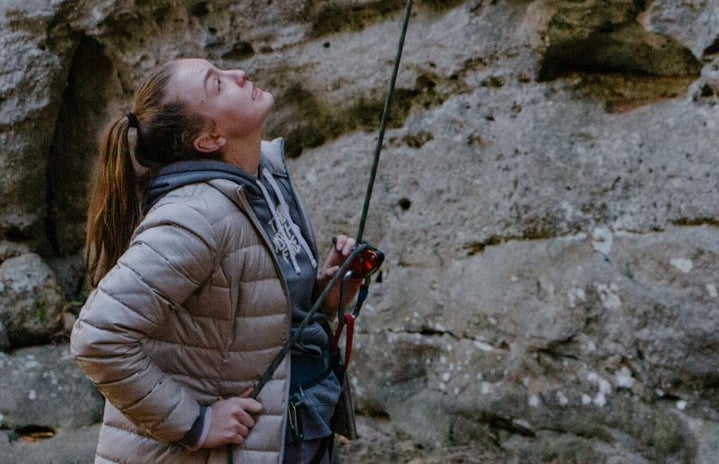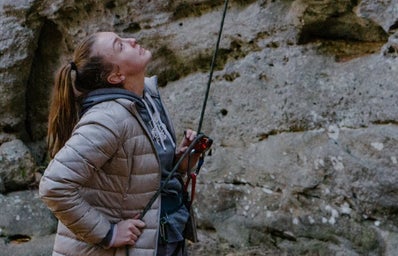This past Sunday was the first time I had ever been rock climbing outside. It’s important to note that I have been rock climbing on and off for two years, but only at indoor gyms. When I signed up for this rock-climbing trip, I had a bunch of thoughts: “What do I wear?” “Will I do good?” “How will I perform?” “Will I get hurt?” All of these questions were running through my head from the day I signed up until I parked my car at the location, Holloway Mountain. I can confidently say now that I have done the climb, that outdoor climbing is so fun and not too scary. If you are a first-time climber or someone who’s climbed for years looking to transition outdoors, here are some tips to make the best out of your trip.
- Go with friends
-
The first and most important tip is to go climbing with close friends or tour guides who are experienced. Knowing your equipment and having the proper experience can be lifesaving. Do not go with people who have just become belay certified or don’t know the ins and outs of outdoor rock climbing and safety. The most important part of rock climbing is the safety aspects.
- Dress for the occasion
-
The second tip I have for you all is picking out comfortable clothing. Rocks are very sharp and often leave lots of bruises, scrapes, and cuts. I suggest wearing leggings and a comfortable t-shirt. I personally brought a hoodie and a rain coat because the weather can change rapidly. Most climbers prefer to wear climbing pants which are loose and allow for stretching. I personally wore a thick pair of leggings because that is what I am most comfortable climbing in. #comfortiskey
- Bring fuel
-
The third tip I have is to bring water and snacks. While this tip is obvious, it is important to make sure you are drinking lots of water and eating snacks with carbs and calories. Climbing is a very energy extensive sport and requires lots of physical strength and energy. Make sure during your rest periods you are staying hydrated and healthy.
- Know where you’re at
-
My fourth tip is understanding your skill level. Indoor climbing grades are very different to outdoor climbing grades. If you climb 5’6 don’t expect to climb this grade outside. When I am at an indoor gym, I traditionally climb a 5’9 to a 5’10. When I went climbing outside, my climb grade dropped to a 5’8 and somewhat a 5’9. While climbing grades are helpful in understanding where you are at skillswise, take these numbers with a grain of salt. Outdoor climbing is a lot harder than indoor climbing. The 5’8 I did took me four attempts to complete it. Just make sure you aren’t too hard on yourself.
- Chalk up
-
Tip five, chalk up. If you are a climber you will know what chalk is and the importance of it. If not, here is a quick lesson. Chalk is simply that, chalk. Gymnasts, crossfitters, athletes, and climbers all use chalk to absorb sweat and sometimes water so you have a better grip. Some people personally do not use chalk, but I do. If you are new to climbing, I highly suggest using chalk or asking your fellow climbers to borrow some. It can be used on your hands, feet, and shoes. If the rock you are climbing is wet from rain or moss, chalk can help your grip to really grab and push on. #climbhard.
- Have fun!
-
My final tip is to have fun. Most people climb because it is a great endurance and strength-building sport, but also because it is super fun. When transitioning to outdoor climbing it can be very scary and intimidating. So long as you aren’t too hard on yourself and don’t give up, you will have an amazing time.
Climbing is one of my favorite hobbies. It makes me smile, laugh, work out, and use my brain. It can be a very tricky sport and at times it can become very frustrating. Your feet will hurt from being in climbing shoes, you’ll sweat a lot, your hands will be cut up, and you’ll leave with some bumps and scrapes, but you’ll also leave with amazing memories. I encourage all of my readers to go climbing outside; I promise you’ll love it. Remember, safety first, fun after. Peace and love babes and I’ll see you soon!
Here are some more links to help with understanding climbing grades!
Climbing Grades: Climbing/Bouldering Ratings | REI Co-op
Rock climbing grades explained: What should you climb? | Sierra Blog



